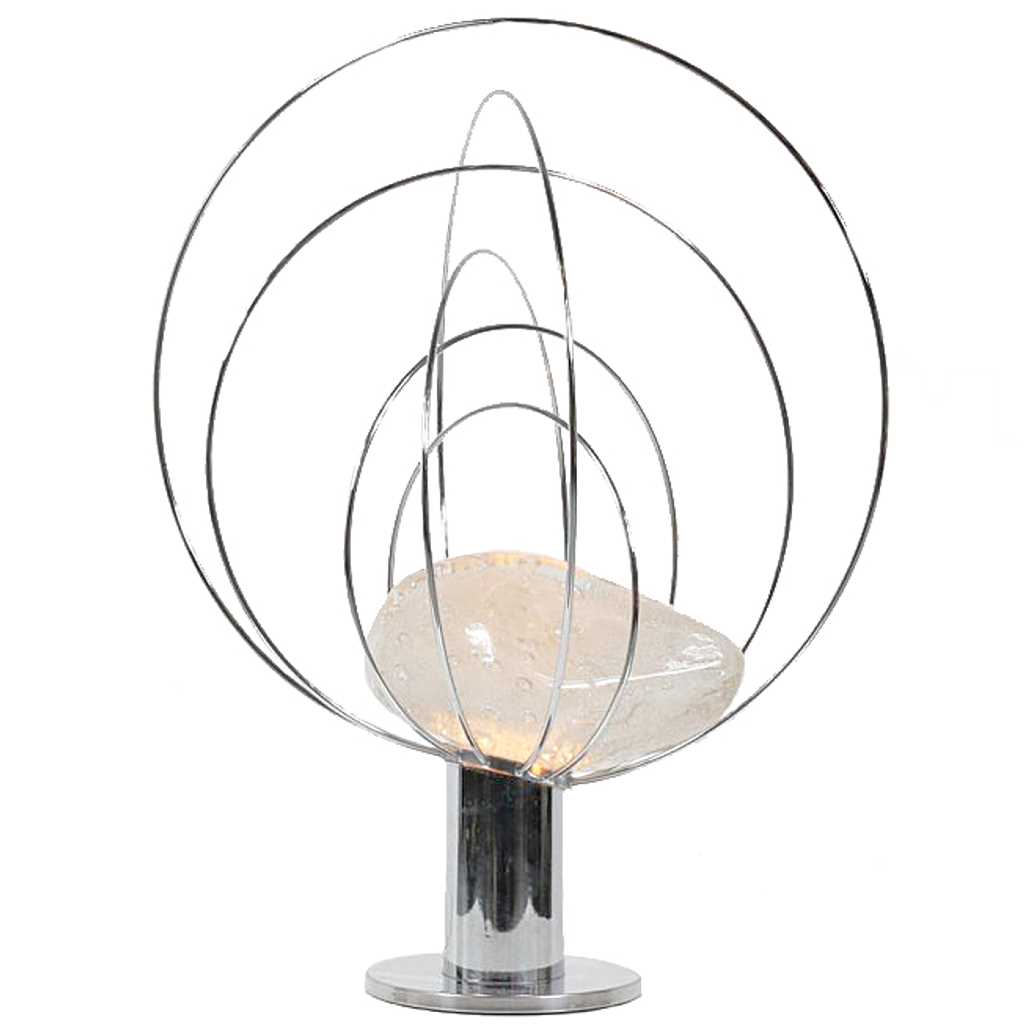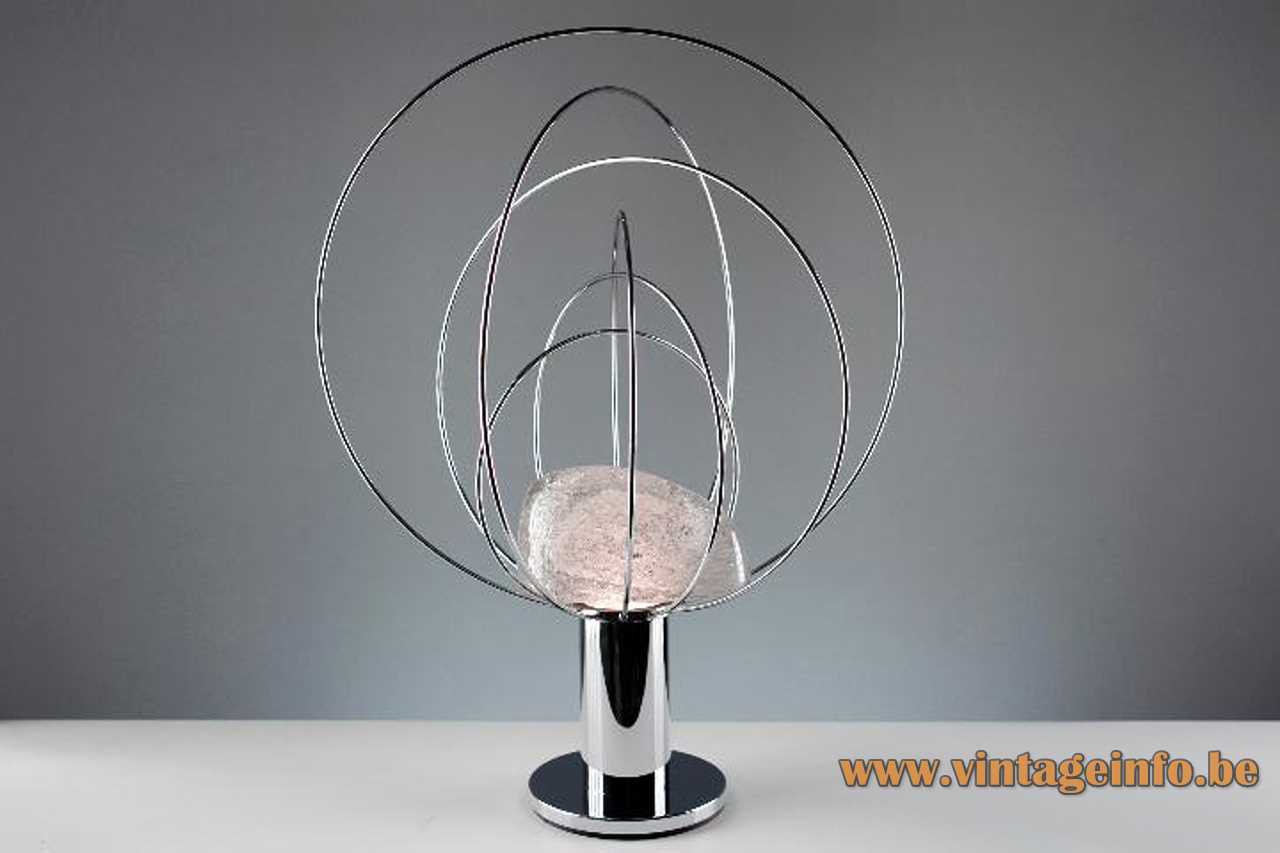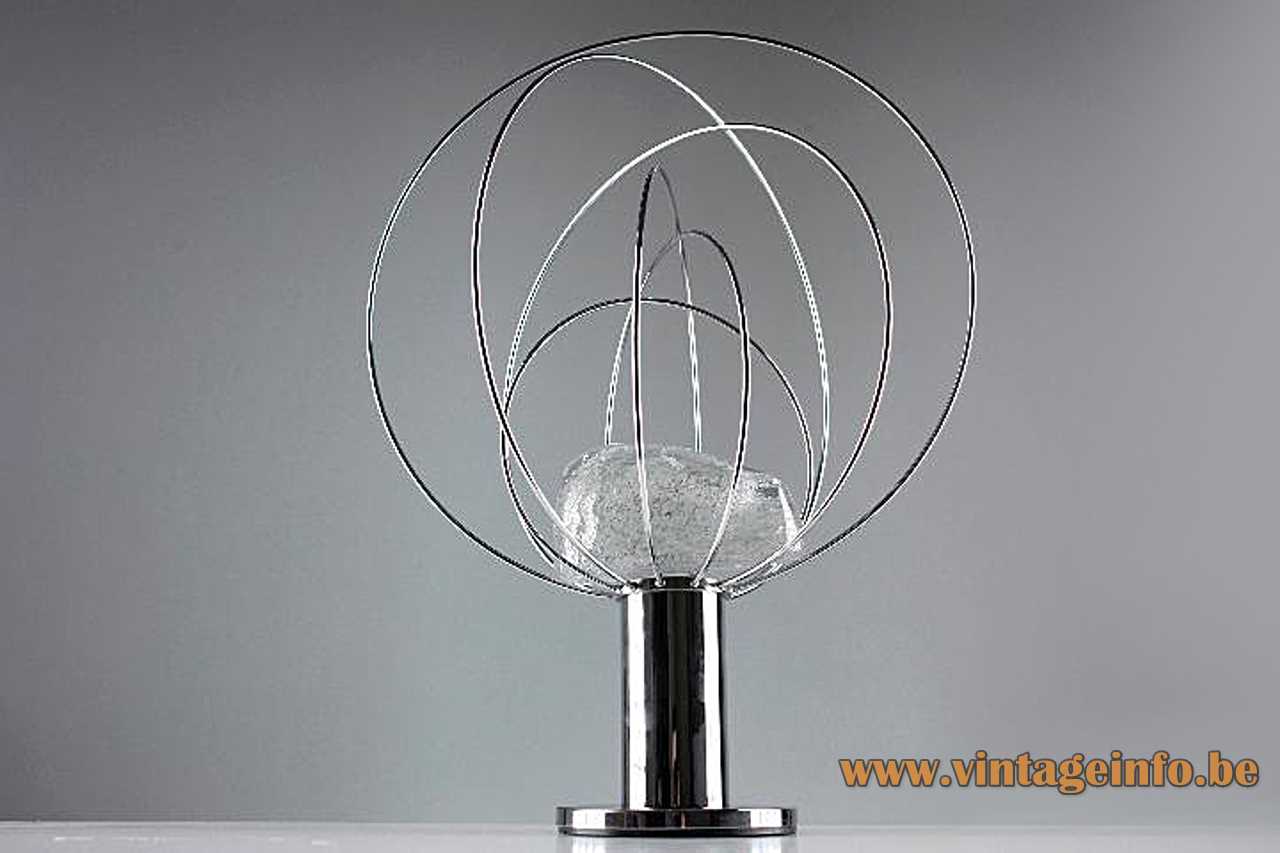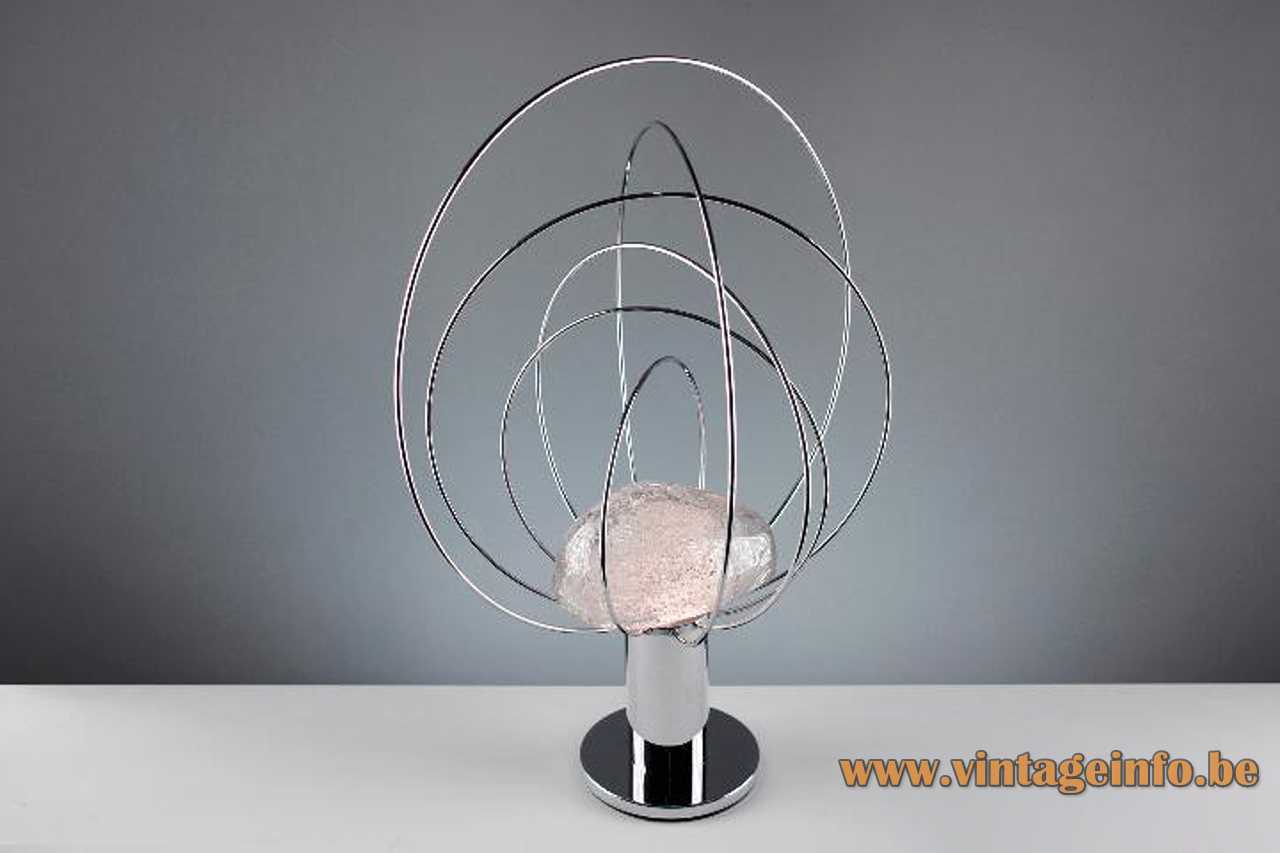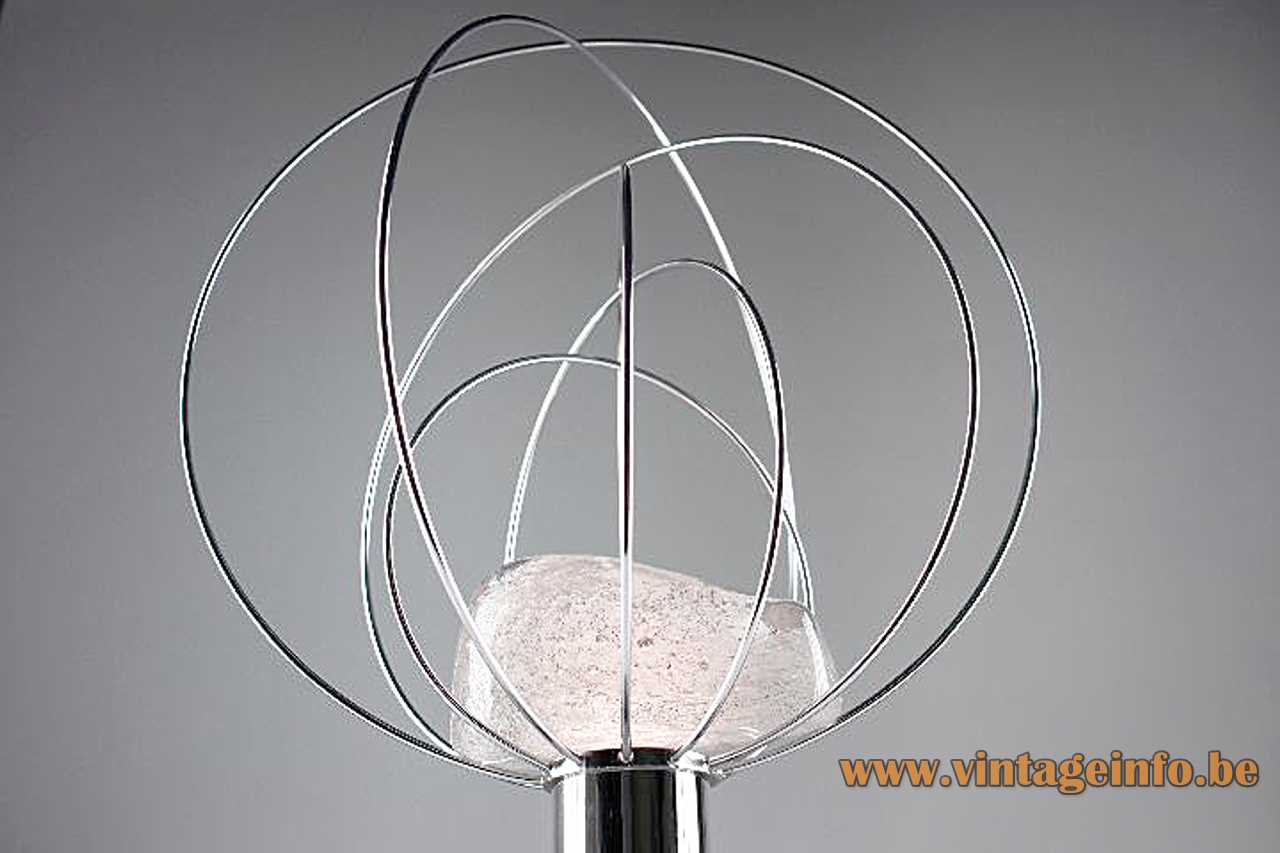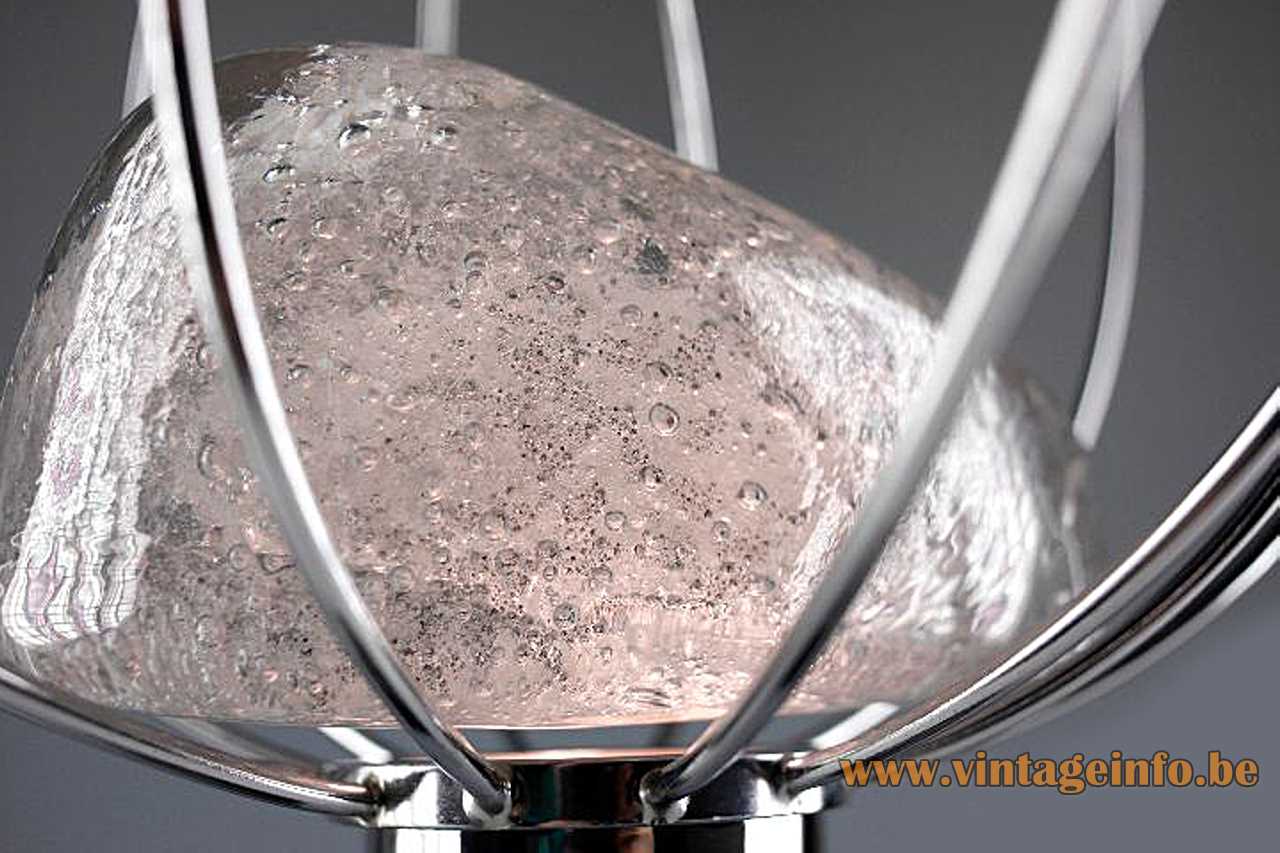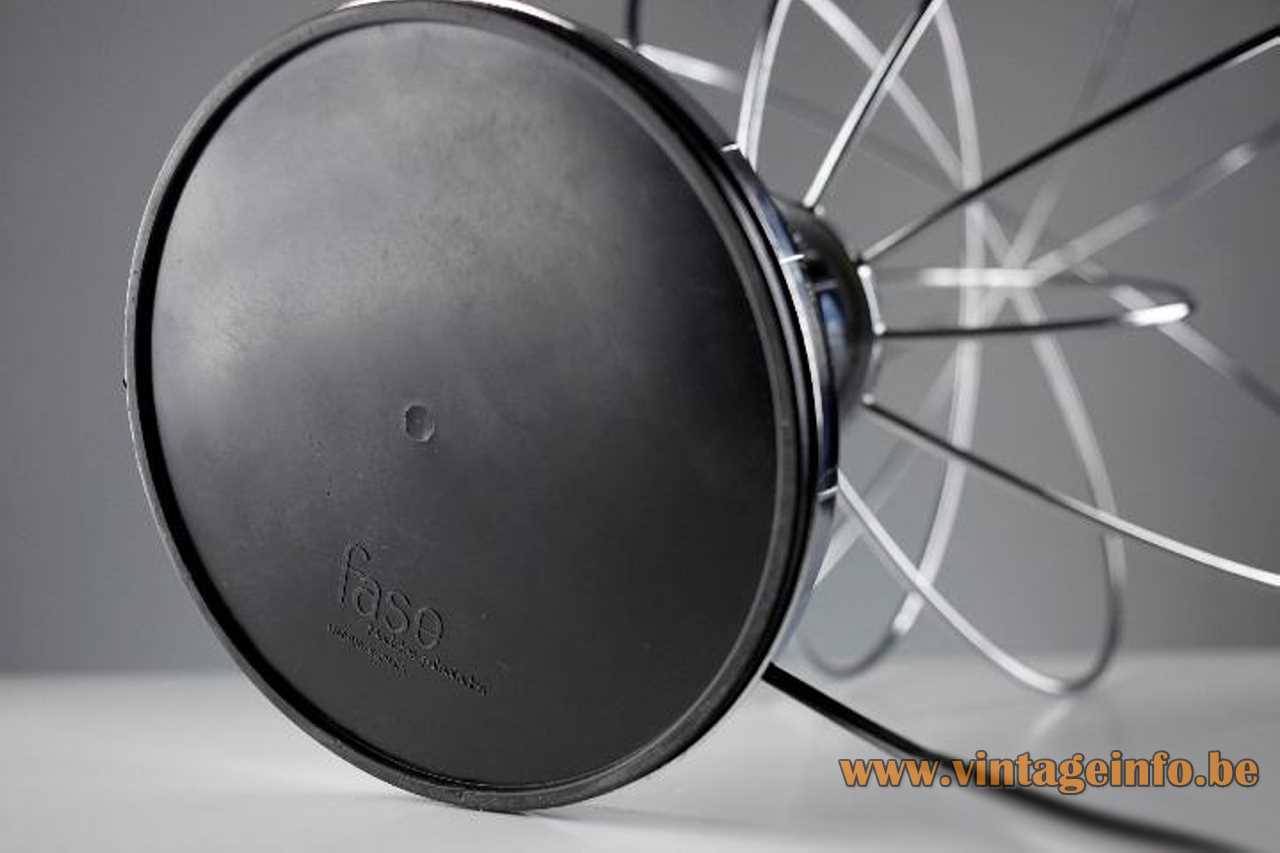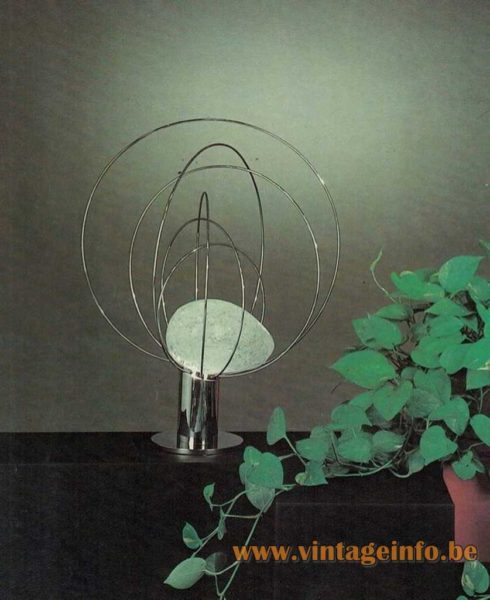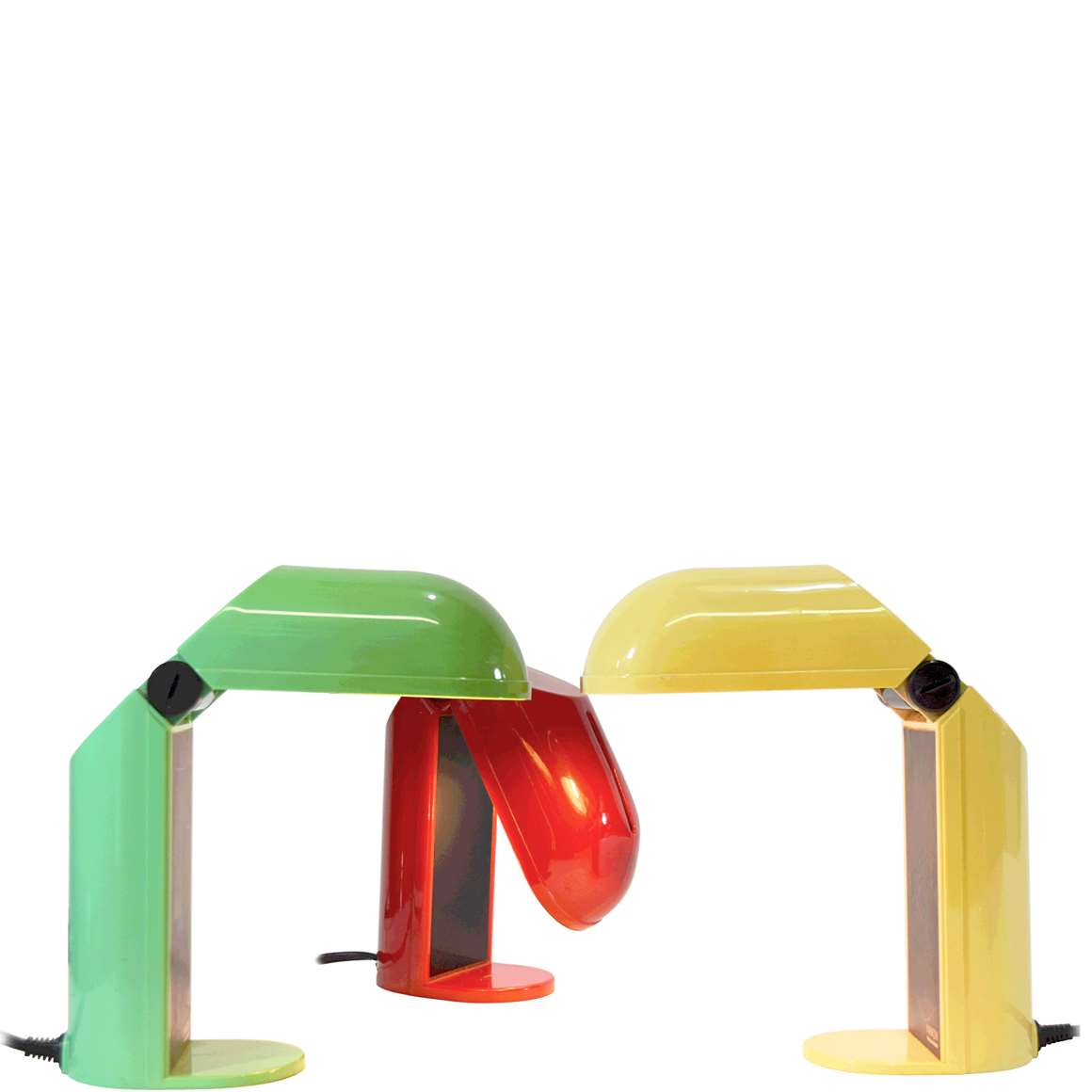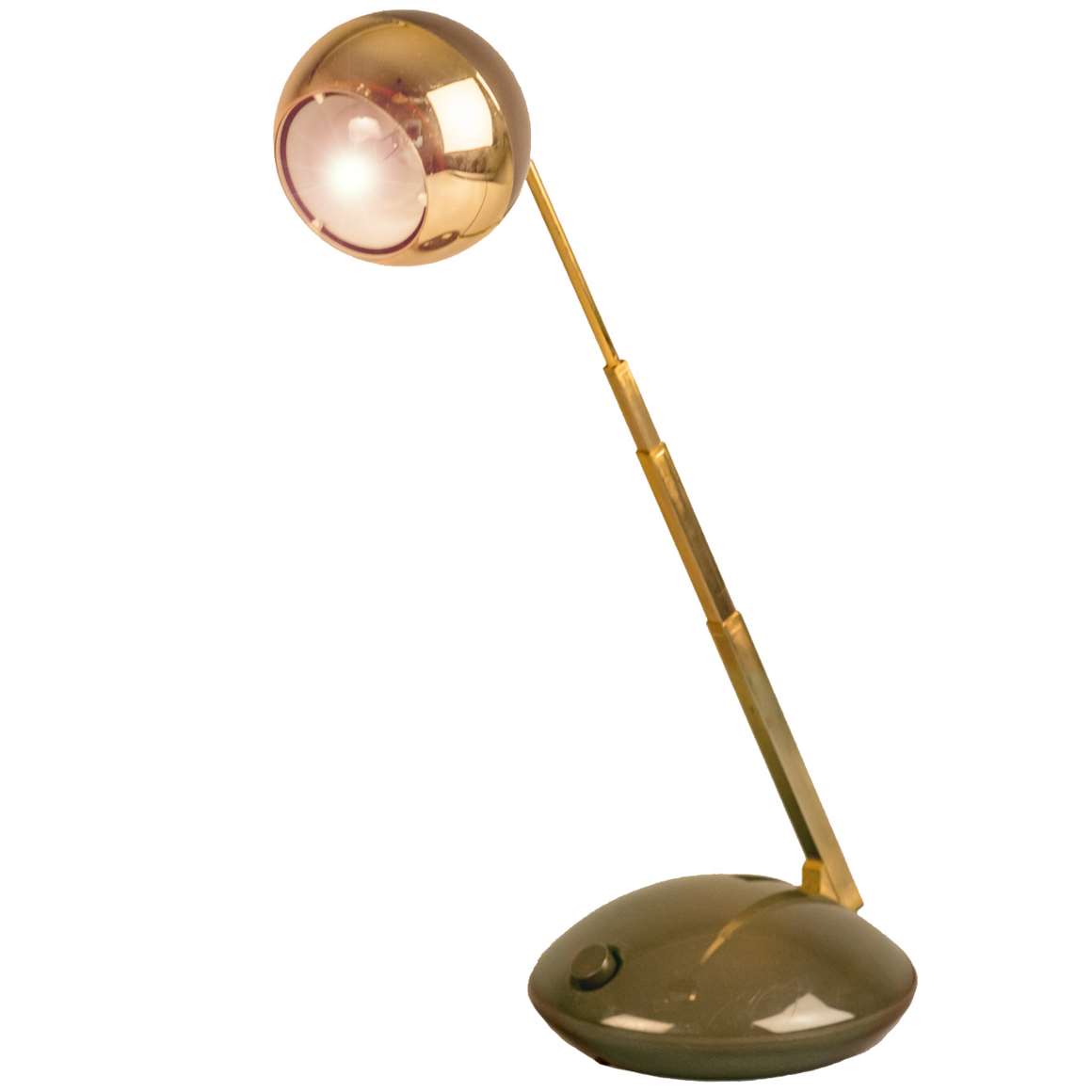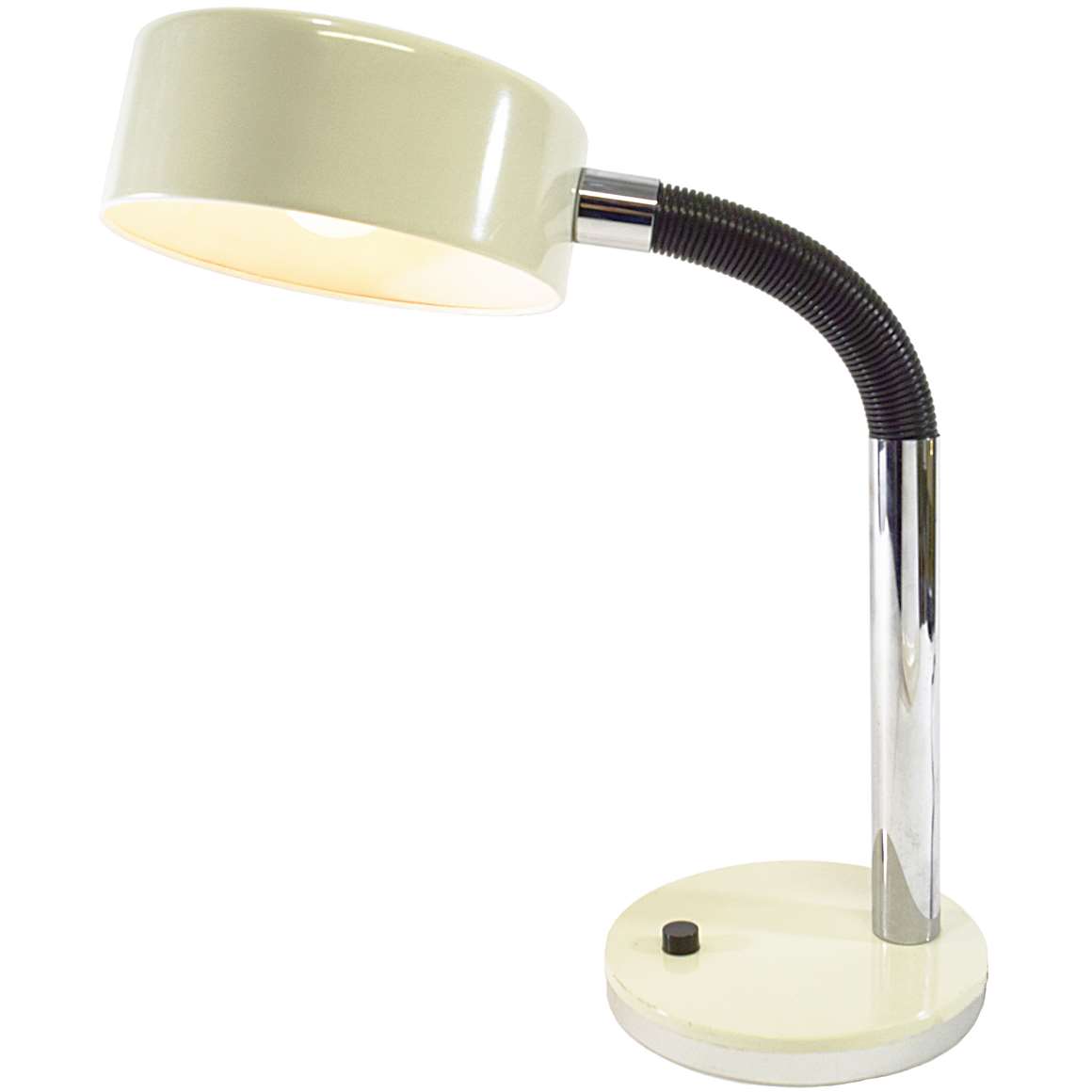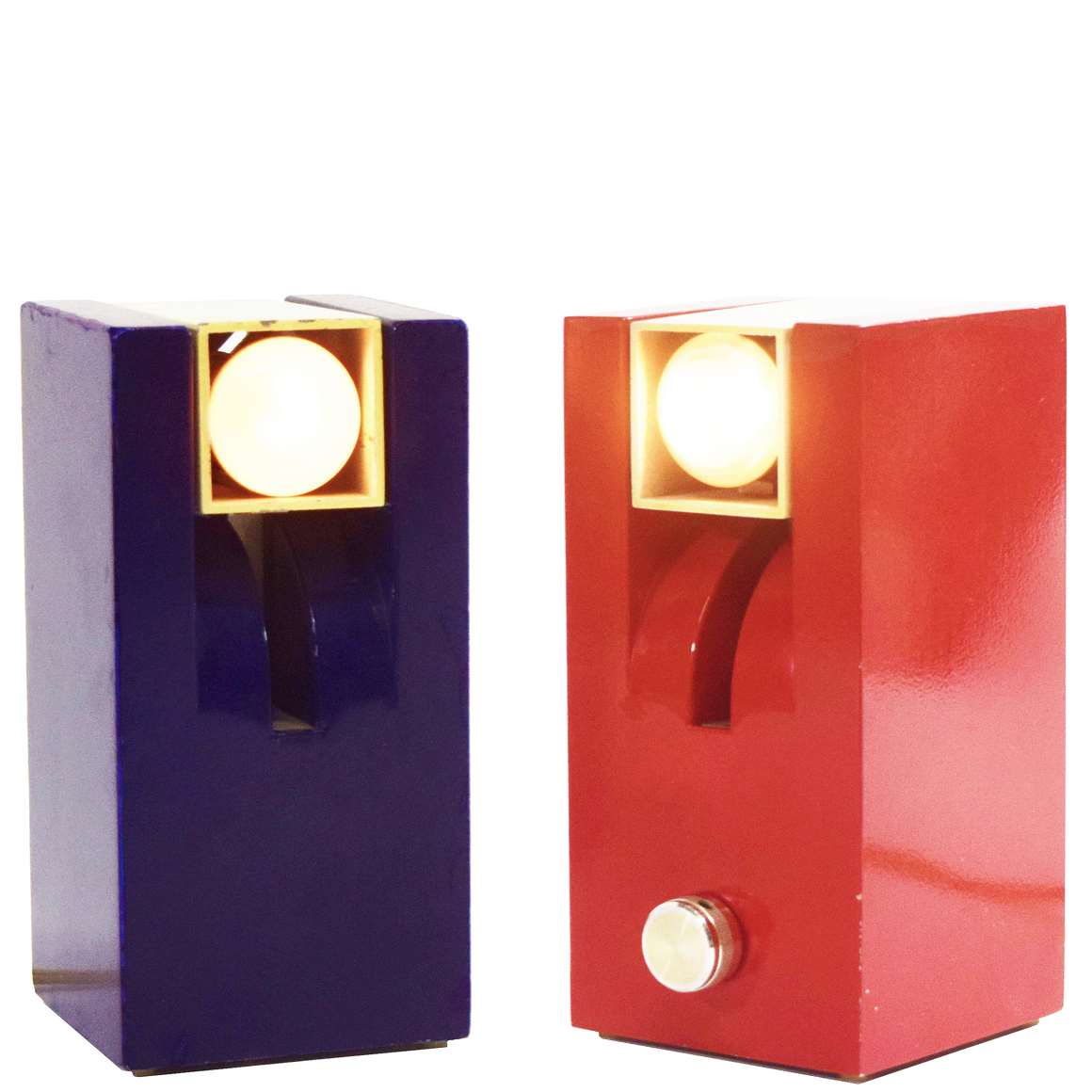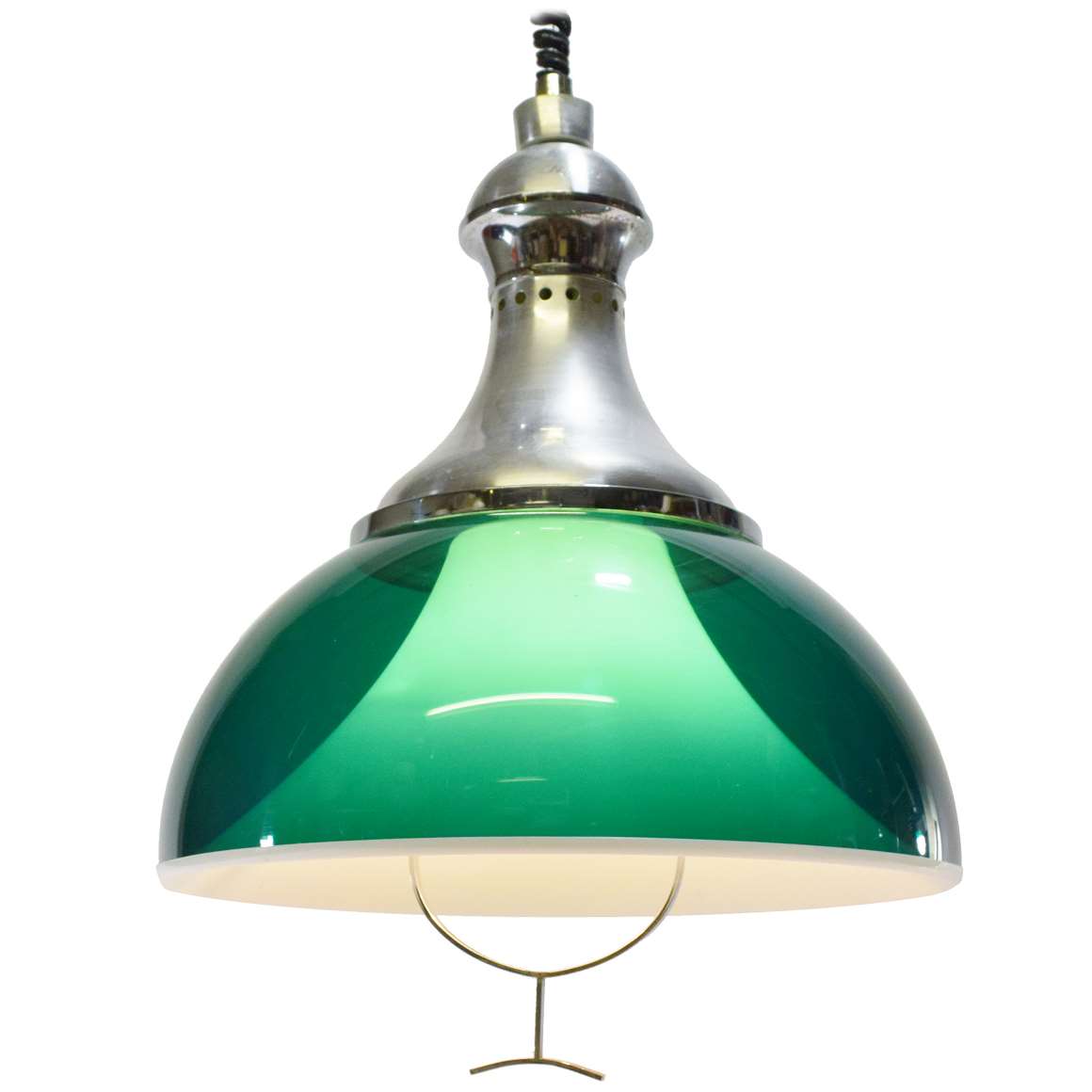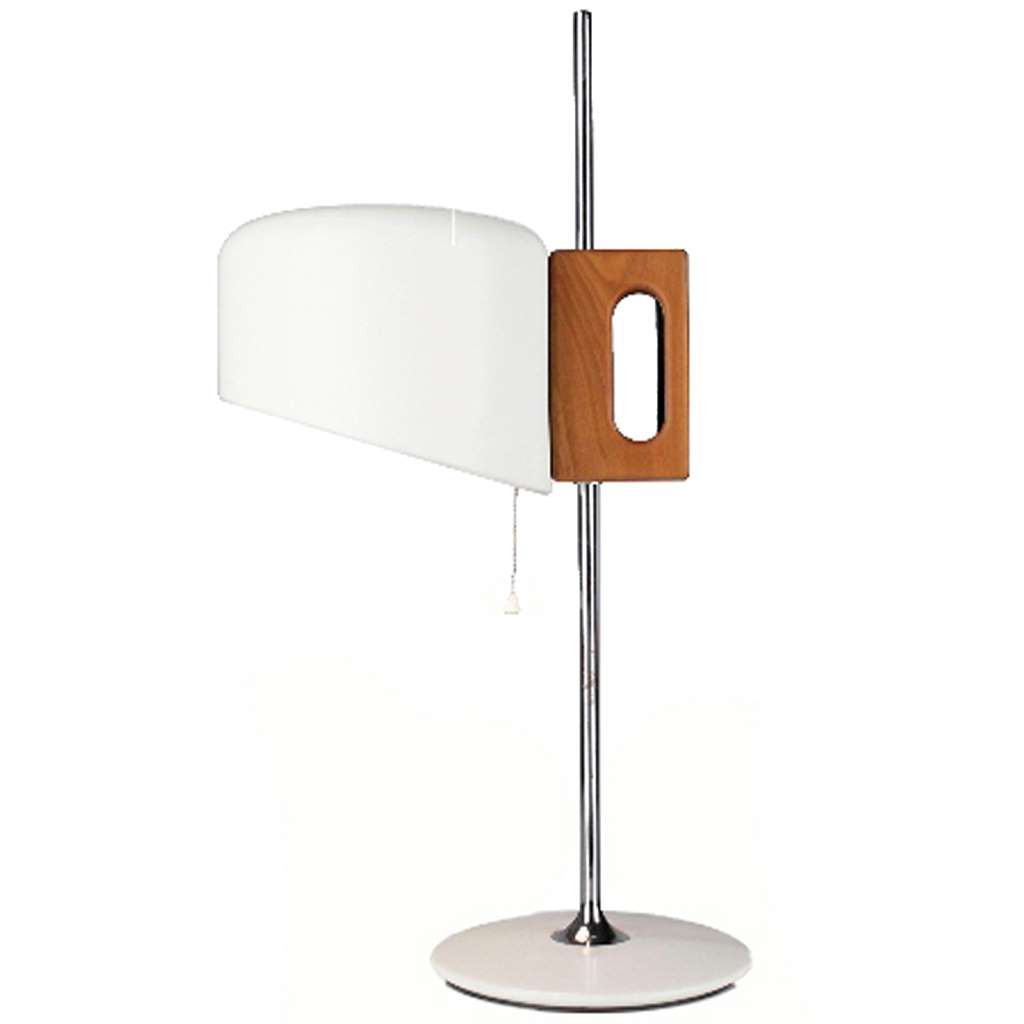Angelo Brotto Barnaba Table Lamp – 1974 Esperia Catalogue Picture
Angelo Brotto Barnaba Table Lamp – 1970s Fase Catalogue Picture
Links (external links open in a new window)
New Barnaba table lamp – Esperia website
Academy of Fine Arts in Venice
Vintageinfo
Striped purple glass chandelier
Many thanks to Lluís from Eclectique Vintage for the photos.
Angelo Brotto Barnaba Table Lamp
Materials: Round chromed metal base (iron) and tube with 6 chrome wire circles, rings in different sizes. A handmade Murano crystal glass stone with bubbles inside (pulegoso). The rock is lies on top of the light source. Bakelite E14 socket.
Height: 60 cm / 23.62”
Width: ∅ 50 cm / 19.68”
Base: ∅ 20 cm / 7.87”
Electricity: 1 bulb E14, 1 x 60 watt maximum, 110/220 volt.
Any type of light bulb can be used. Not a specific one preferred.
Period: 1970s – Mid-Century Modern.
Designer: Angelo Brotto in 1974.
Manufacturer: Esperia, Via Campania, 1D, 53036 Poggibonsi, Italy.
Other versions: This Angelo Brotto Barnaba table lamp exists in chrome and brass. It was also produced as a floor lamp. This lamp was made by Esperia for the Spanish lighting company Fase. Fase named it: Planeta.
This Angelo Brotto Barnaba table lamp was designed in 1974. It appears in a Fase catalogue from 1976. Around 2019 it went back in production by Esperia.
Angelo Brotto
Born in Venice, Italy, in 1914, and passed away in Campiglia Marittima in 2002. Angelo Brotto studied at the Art School of Venice, where he began exhibiting his work even before graduation. In 1941 he completed his studies at the Academy of Fine Arts in Venice, distinguishing himself by winning every major student competition of his time.
In the years that followed, Brotto received numerous awards for his artistic achievements. His works have been acquired by the Gallery of Modern Art in Rome and Venice, the Rivoltella Museum in Trieste, the Venice Biennale, the Italian Ministry of National Education, the Confederazione Italiana Professionisti ed Artisti, and by several private galleries worldwide.
Esperia
Esperia was founded in 1952 in Poggibonsi, Tuscany, by three friends, Romano Conforti, Eugenio Cortigiano and Mario Moni, who shared the ambition to build a design and lighting company in post-war Italy. Initially rooted in the Tuscan glassmaking tradition, the firm soon expanded its expertise to lighting and furniture design.
During the 1960s, Esperia experienced a period of great creativity and international recognition, largely thanks to its collaboration with Venetian designer and professor Angelo Brotto. Brotto created some of the brand’s most iconic pieces, including the Quasar, Manhattan, Shangrila, Gioa, Gaspare, Ursula, Barnaba, 6038, Astrid, Natalia, Tea, Kit, Giraffa, Pagoda, and Barbarella lamps – all now emblematic of Italian design from the 1960s and 70s.
Esperia ’s designs were presented at major exhibitions such as the Salone del Mobile and Euroluce in Milan, and the company also collaborated with renowned glassmakers like Venini.
Today, Esperia continues to operate in Tuscany, maintaining in-house design and production facilities. With over 70 years of experience, the company remains dedicated to craftsmanship and innovation in contemporary lighting. Esperia designers are: Cristina Celestino, Silvano Pulcinelli and the internal design team named Centro Stile Esperia.
Esperia is also a genus of moths and an historic Italian motorcycle brand. Esperia is also a comune in the Italian province of Frosinone.
Pulegoso
Italian word taken from the dialect word pulega, which means bubble. The glass is containing numerous bubbles of all sizes, produced by adding bicarbonate/soda, gasoline, or other substances to the glass. The bubbles make the glass semi-opaque and give the surface an irregular texture. The technique was developed in the 1920s by Napoleone Martinuzzi (1892-1977) on the island of Murano, Italy and used for the first time by the famous Venini company.
Fase
The Fase company was founded by self-made man Pedro García Martin and designer Luis Pérez de la Oliva.
The Boomerang 64 lamp was one of their first designs in 1964, you find it over here on Vintageinfo. Initially they sold their self-produced lamps to the markets in and around the capital Madrid before successfully opening a factory in Torrejón de Ardoz on the outskirts of the city.
They produced mainly lamps, but also ashtrays and other products such as office bins and coat racks.
Fase supplied many lamps to the offices of General Franco ‘s dictatorial government and the Guardia Civil, some sort of military police. From 1975 on, after the death of Franco and the end of the regime, Fase started with Italian Modern and Bauhaus -inspired designs. The Spaniards were unfamiliar with this design because of the Franco regime that ruled the country with an iron fist and allowed few foreign influences.
During the 70s Fase exported lamps to Belgium, The Netherlands, Luxembourg, Great Britain, Norway, France, Italy, Germany, Portugal, United Arab Emirates, Japan, Hong Kong, Morocco, the United States and Canada. In total in more than 32 countries.
The 1980s
In the 1980s Fase jumped on the bandwagon of the halogen lighting. The break with tradition proved unsuccessful and ultimately contributed to the end of the business. A large fine of the Treasury in the early nineties for tax irregularities was the end for Fase. The company was officially dissolved in 1996.
Drowned, the company sold its manufacturing license to a German brand, Ma-Of, which slightly modified the original design by adding more chrome. Before these final death rattles, the partners had already separated. GEI (Gabinete Estudios Industriales – Cabinet Industrial Studies) was another company that sold similar lamps. Also Massive from Belgium produced a few lamps in this style.
When the company stopped producing them abruptly, there was a lot of ‘stock’ available in the warehouses. That’s why you find relatively many lamps with a label attached. Many lamps are sold new and never used in the box (NOS – New Old Stock).
Designers who have worked for the company include : Gabriel Teixidó. He designed the Iberia and Meca series and Tomás Díaz Magro, responsible for the Apolo, Minifase and Impala lamps. The most productive was Luis Pérez de la Oliva, who designed the majority of the Fase lamps.
Fase also sold lamps made by others such as the Yamada Shomei ‘Manon ’ table lamp from Japan. You can find it over here on Vintageinfo. The Prisma table lamp was produced in Italy by F.A.A.I. Arredo. Also the Sinus stacking ashtray made by Helit from Germany. A design by Walter Zeischegg from 1967. You can find it here in the MoMA, New York. Fase also sold lamps from other companies.
LUPELA
LUPELA was founded by LUis PErez L’Anzas (acronym of “lupela”). Luis had two sons: Fernando Perez de la Oliva, who later registered the LUPELA trademark, and Luis Pérez de la Oliva, who founded Fase, together with Pedro Martin. Fernando bought the production rights for 5 lamps by designer Jose Luis Gugel Sacha: the Reina, Cobra, Cisne and models 225 and 226. He agreed with his brother Luis that Fase would not produce articulated lamps. They did not keep to the agreement and Fase designed and produced many lamps inspired by LUPELA models.
